Welcome to our guide to the best lenses currently available for the Canon R7 mirrorless camera in 2025.
In this guide you’ll find our top lens recommendations as well as a complete list of all RF lenses compatible with the Canon EOS R7 including the latest firmware version for each lens.
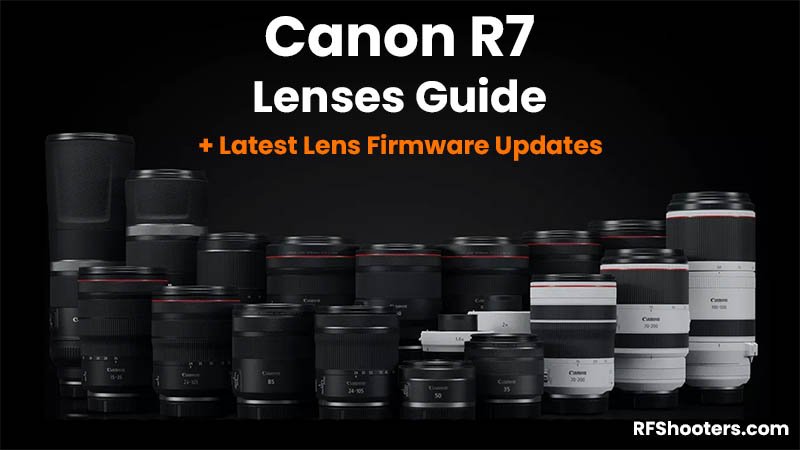
If you find this guide helpful you might also enjoy our Canon R7 Memory Card Guide where we have tested over 20 memory cards in-camera. And if you are looking for accessories then our Canon R7 Accessories Guide is worth a look too.
Table of Contents[Hide][Show]
- Compatible Lenses
- What To Consider When Choosing a Lens
Our 12 Best Lens Recommendations+−
- 1. Sigma 10-18mm F2.8 DC DN Contemporary
- 2. Sigma 18-50mm F2.8 DC DN Contemporary
- 3. Canon RF-S 18–45mm F4.5–6.3 IS STM
- 4. Canon RF-S 18–150mm F3.5–6.3 IS STM
- 5. Canon RF 15-30mm F4.5-6.3 IS STM
- 6. Canon RF 50mm F1.8 STM
- 7. Canon RF 85mm F2 Macro IS STM
- 8. Canon RF 24-105mm F4L IS USM
- 9. Canon RF 70-200mm F4L IS USM
- 10. Canon RF 100-400mm F5.6-8 IS USM
- 11. Canon RF 100-500mm F4.5-7.1L IS USM
- 12. Canon RF 800mm F11 IS STM
- Canon RF-S Zoom Lens List
- Canon RF Prime Lens List
- Canon RF Zoom Lens List
- Canon EF to RF Lens Mount Adapters
- Canon RF Extenders
- Canon R7 Guides & Resources
Canon R7 Forum & Facebook Group
If you are looking for further help and advice on the Canon R7 or would simply like to share your photos and videos, then please head over to our friendly Forum. If you prefer Facebook then we also run the Canon R7 Shooters Group.
Compatible Lenses
The Canon R7 has an APS-C sensor and features Canon’s RF-Mount. It is compatible with both Canon RF-S (APS-C) lenses and also Canon RF (Full-Frame) lenses.
You can also use older Canon EF and EF-S lenses providing you use an EF-RF Lens Mount Adapter.
What To Consider When Choosing a Lens
- Focal range: The focal length indicates the angle of view of a lens. A wide-angle lens may have a focal length of 12-24mm. Wide-angle lenses are great for landscapes, astrophotography, architecture and real estate. A telephoto lens may be 100mm, 200mm, 400mm. These are great for getting closer to your subject such as when shooting sports or wildlife.
- Aperture: Aperture refers to the opening of a lens’s diaphragm through which light passes. It’s measured in f-stops such as f/2.8, f/4, f/5.6 etc. The smaller the number the wider the aperture. An f/2.8 lens would be the best choice for indoor and poorly lit photography but these are typically the most expensive lenses.
- Prime or zoom: A prime lens has a fixed focal length and if you want to change the framing of your subject you need to move forwards or backwards with your feet. A zoom lens allows you to change from one focal length like 100-500mm with a simple rotation of a zoom ring. Typically prime lenses have better image quality than zoom lenses but today’s zooms still offer very good image quality with some even surpassing prime lenses.
Our 12 Best Lens Recommendations
Here are our top 12 lens recommendations for the Canon R7 including reviews worth watching to learn more about each lens.
You’ll find a complete list of all compatible RF and RF-S lenses together with the latest firmware versions a little further down this article.
1. Sigma 10-18mm F2.8 DC DN Contemporary
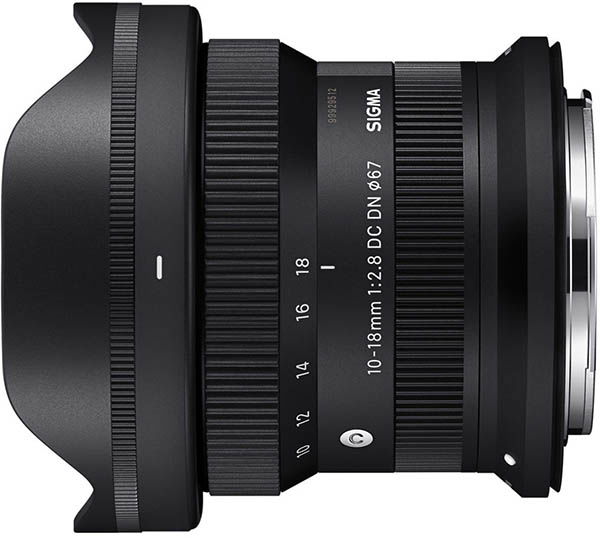
The Sigma 10-18mm F2.8 DC DN Contemporary lens is designed specifically for APS-C cameras like the Canon R7.
This lens has been available for Sony E-mount, L-mount and Fujifilm X-mount for some time already where it has established itself as one of the most popular third-party lenses.
It might have taken a while but Sigma have finally made an RF version for Canon Shooters to enjoy.
A fast and quiet stepping motor is used to deliver precise AF when shooting stills and video. It is fully compatible with in-camera AF tracking modes.
The lens has a focal range from 10-18mm and a constant maximum aperture of F2.8, the minimum aperture is F22. This is an external zoom lens so the front element does extend when you zoom in.
At 10mm it has a minimum focusing distance of 11.6 cm, this is reduced to 19.1cm at 18mm. The maximum magnification is 1:4.
The lens is constructed from 13 elements in 10 groups (3 FLD, 1 SLD, and 4 aspherical elements) and it has 7 aperture blades. There’s a 67mm front filter thread.
The lens measures approx. 2.8 in. (72.2mm) in diameter and 2.4 in (62.0mm) in length. It weighs in at just 270g / 9.5oz.
To learn more about this lens we recommending watching this review from Dustin Abbott:
Pros:
- Compact and lightweight
- Well built and weather sealed
- Bright F2.8 aperture
- Great AF performance for still and video
- Practically no focus breathing
- Very good sharpness across the zoom range
- Good flare resistance
Cons:
- No optical stabilization
- Strong barrel distortion at 10mm
- More expensive than the Canon RF-S 10-18mm F4.5-6.3 IS STM
2. Sigma 18-50mm F2.8 DC DN Contemporary
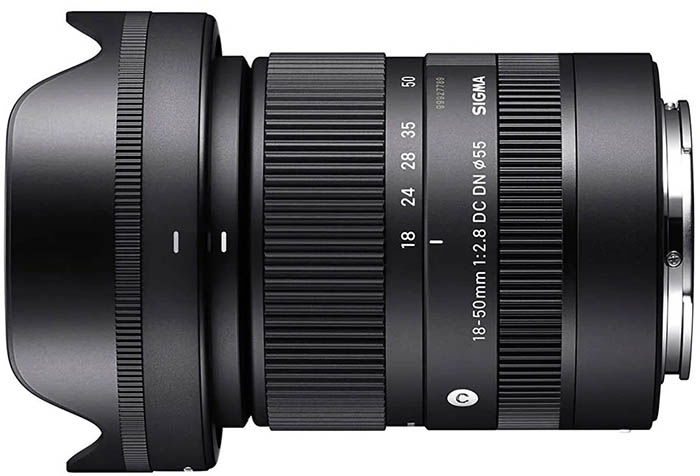
The Sigma 18-50mm F2.8 DC DN Contemporary lens is like the 10-18 has also been designed specifically for APS-C cameras like the Canon R7.
This lens has also been available for Sony E-mount, L-mount and Fujifilm X-mount for some time already where it has established itself as one of the most popular third-party lenses.
A exceptionally fast and quiet stepping motor is used to deliver precise AF when shooting stills and video.
The lens has a focal range from 18-50mm and a constant maximum aperture of F2.8, the minimum aperture is F22. This is an external zoom lens so the front element does extend when you zoom in.
At 18mm it has a minimum focusing distance of 12.1 cm, this is reduced to 30cm at 50mm. The maximum magnification is 1:2.8 at 18mm and 1:5 at 50mm.
The lens is constructed from 13 elements in 10 groups (1 SLD and 3 aspherical lenses) and it has 7 aperture blades. There’s a 55mm front filter thread.
The lens measures approx. 2.7 in. (69.2mm) in diameter and 2.9 in (74.5mm) in length. It weighs in at just 300g / 10.6oz.
To learn more about this lens we recommending watching this review from Christopher Frost:
Pros:
- Compact and lightweight
- Well made and weather sealed
- Great focal length and constant F2.8 aperture
- Great autofocus performance for stills and video
- Minimal focus breathing
- Good sharpness across zoom range
- Lovely bokeh
Cons:
- No optical stabilization
- Barrel distortion at 18mm
- Some ghosting in certain conditions
3. Canon RF-S 18–45mm F4.5–6.3 IS STM
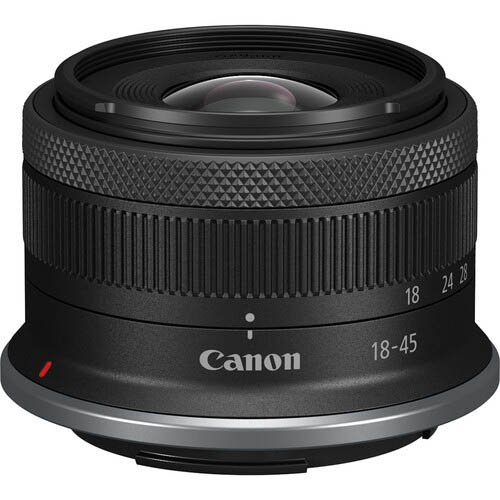
The Canon RF-S 18–45mm F4.5–6.3 IS STM is designed specifically for APS-C cameras like the Canon R7. It’s a great little lens to get you started and is ideal for travel, family or even vlogging.
An STM autofocus motor drives the lens elements and a 4-stop Image Stabilizer helps to keep your images sharp even at slower shutter speeds. This increases to 6.5 stops when combined with the R7’s IBIS (In-Body Image Stabilization).
The lens has a focal range from 18-45mm (29-72mm full-frame equivalent) and a variable maximum aperture of F4.5-6.3, the minimum aperture is F22-32. This is an external zoom lens so the front element extends when you zoom in.
At 18mm it has a minimum focusing distance of 20cm with autofocus and this is reduced to 15cm when using manual focus. At 45mm the minimum focusing distance of 35cm with autofocus and this is reduced to 25cm when using manual focus.
The maximum magnification is 0.14x at 18mm with autofocus and 0.25x with manual focus. At 45mm the maximum magnification is 0.16x with autofocus and 0.26x with manual focus.
The lens is constructed from 7 elements in 7 groups and it has 7 aperture blades and there’s a 49mm front filter thread. The lens includes a zoom ring and focus/control ring.
The lens measures approx. 2.7 in. (68.9mm) in diameter and 1.7 in (44.3mm) in length. It weighs in at just 4.6 oz. / 0.3 lb. / 130g.
A lens hood is unfortunately not included and needs to be purchased separately. The correct lens hood for the Canon RF-S 18–45mm F4.5–6.3 IS STM lens is the Canon EW-53 (B&H | Amazon).
To learn more about this lens we recommending watching this review from Gordon Laing.
Pros:
- Super small and light in weight
- Relatively cheap
- 4 stops of stabilization increasing to 6.5 stops with the R7’s IBIS
- Reasonable sharpness across the frame
Cons:
- Slow maximum aperture
- No hood supplied in the box
- No weather sealing
- Poor autofocus in low light
4. Canon RF-S 18–150mm F3.5–6.3 IS STM
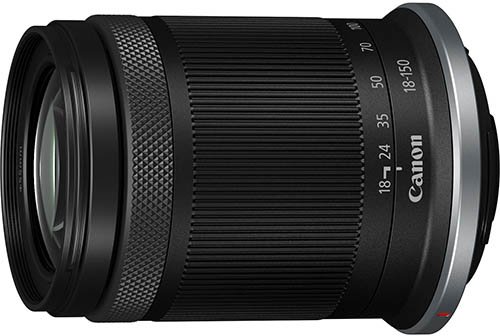
If the RF-S 18–45mm isn’t quite long enough then the Canon RF-S 18–150mm F3.5–6.3 IS STM with its 8.3x zoom is a great alternative.
If you ordered the Canon R7 lens bundle (B&H) then this is the lens that it comes with. It’s a useful lens for shooting landscapes, nature, wildlife, sports or travel.
The smooth STM autofocus motor drives the lens elements and a 4.5-stop Image Stabilizer will help to keep your images sharp even at slower shutter speeds. This increases to 7 stops when combined with the R7’s IBIS (In-Body Image Stabilization).
The lens has a focal range from 18-150mm (29-240mm full-frame equivalent) and a variable maximum aperture of F3.5-5.6, the minimum aperture is F22-40. This is an external zoom lens so the front element extends when you zoom in.
At 18mm it has a minimum focusing distance of 17cm with autofocus and this is reduced to 12cm when using manual focus. At 150mm the minimum focusing distance is 45cm with both autofocus and manual focus.
The maximum magnification is 0.2x at 18mm with autofocus and 0.44x with manual focus. At 150mm the maximum magnification is 0.31x with both auto and manual focus.
The lens is constructed from 17 elements in 13 groups and it has 7 aperture blades and a 55mm front filter thread. The lens includes a zoom ring and dual function focus/control ring.
The lens measures approx. 2.7 in. (68.9mm) in diameter and 3.3 in (83.82mm) in length. When fully extended at 150mm the length increases to 5.0 in. (127mm). It weighs in at 10.9 oz. / 0.7 lb. / 310g.
A lens hood is unfortunately not included and needs to be purchased separately. The correct lens hood for the en the Canon RF-S 18–150mm F3.5–6.3 IS STM lens is the Canon EW-60F (B&H | Amazon).
To learn more about this lens we recommending watching this review from Gordon Laing.
Pros:
- Great focal range in a small and compact body
- Relatively cheap
- 4.5 stops of stabilization increasing to 7 stops with the R7’s IBIS
- Reasonable sharpness across the frame
Cons:
- Slow maximum aperture
- No hood supplied in the box
- No weather sealing
- Poor autofocus in low light
5. Canon RF 15-30mm F4.5-6.3 IS STM
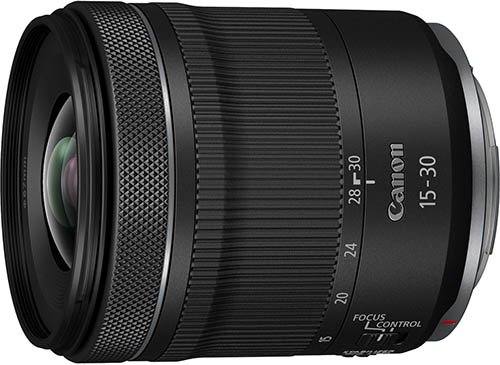
The Canon RF 15-30mm F4.5-6.3 IS STM is a full-frame zoom lens that still pairs well with the R7.
If you plan to purchase a full-frame camera like the R5 or R6 further down the line then then you won’t need to shoot in crop mode like you would with the RF-S lenses.
The autofocus is powered by an STM motor and there’s a 5.5-stop Image Stabilizer that increases to 7 stops when combined with the R7’s IBIS (In-Body Image Stabilization).
The lens has a focal range from 15-30mm (24-48mm full-frame equivalent) and a variable maximum aperture of F4.5-6.3 and minimum aperture of F22-32. With this wide focal range the lens is a good choice for landscape, architecture and interior shots.
This is an external zoom lens so the front element does extend when you zoom in.
When shooting in autofocus the lens has a constant minimum focusing distance of 28cm throughout the zoom range. Switch to manual focus and this drops to 12.8cm at 15mm but increases to 28cm at 20mm and 30mm.
The maximum magnification is 0.29x at 15mm with autofocus and 0.128x with manual focus. At 30mm the maximum magnification is 0.16x with both auto and manual focus.
The lens is constructed from 13 elements in 11 groups and it has 7 aperture blades and a 67mm front filter thread. The lens includes a zoom ring and dual function focus/control ring with a switch on the body, there’s also an IS on/off switch.
The lens measures approx. 3.0 in. (76.6mm) in diameter and 3.5 in (88.4mm) in length. It weighs in at 13.6 oz. / 0.9 lb. / 390g.
Like many of Canon’s more budget friendly STM lenses there is no lens hood included and this needs to be purchased separately. The correct lens hood for the Canon RF 15-30mm F4.5-6.3 IS STM lens is the Canon EW-73E (B&H).
There aren’t too many reviews available for this lens right now but we recommending watching this video from Canon photographer Paul Seibert.
Pros:
- Wide 15mm focal length
- Relatively cheap
- 4.5 stops of stabilization increasing to 7 stops with the R7’s IBIS
- Good sharpness across the frame
Cons:
- Slow maximum aperture
- No hood supplied in the box
- No weather sealing
6. Canon RF 50mm F1.8 STM
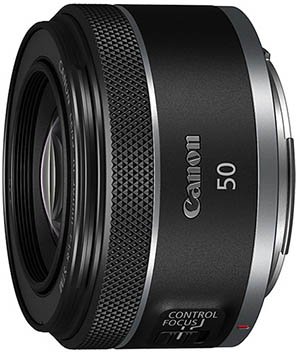
The Canon RF 50mm F1.8 STM is a full-frame lens that is still a great match for the Canon EOS R7.
If you are looking for a nifty fifty prime lens for everyday shots, portraits and expressing your creativity then this is definitely a lens that you will want to take a closer look at.
The autofocus is powered by an STM motor but there is no in-lens image stabilization. However, with the R7’s IBIS (In-Body Image Stabilization) you will still comfortably be able to shoot hand-held images.
The lens has a fixed focal length of 50mm (80mm full-frame equivalent) and a fast maximum aperture of F1.8 and a minimum aperture of F22.
The minimum focusing distance is 30cm and the maximum magnification is 0.25x.
I own this lens myself and it is a fantastic little lens for the price. I’ve yet to use it on the R7 but here’s a shot of my dog Frank taken with my Canon R5.
The lens is constructed from 6 elements in 5 groups and it has 7 aperture blades and a 43mm front filter thread. The lens features a dual function focus/control ring with a switch on the body.
The lens measures approx. 2.72 in. (69.2mm) in diameter and 1.59 in (40.5mm) in length. It weighs in at 5.6 oz. / 0.35 lb. / 160g.
There is no lens hood included in the box so this would need to be purchased separately if required. The correct lens hood for the Canon RF 50mm F1.8 STM lens is the Canon ES-65B (B&H | Amazon).
To learn more about this excellent little lens we would recommending watching this review from Christopher Frost.
Pros:
- Improved build quality over previous EF 50mm F1.8 lenses
- Good focus accuracy from STM motor
- Good center sharpness even wide open at f/1.8
- Pleasing bokeh
- Great price
Cons:
- Fairly heavy vignette
- No lens hood included
- Corners aren’t very sharp at wider apertures
7. Canon RF 85mm F2 Macro IS STM
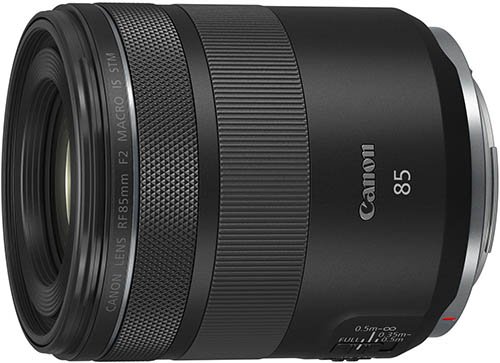
The Canon RF 85mm F2 Macro IS STM is a full-frame prime lens and a great match for the Canon EOS R7.
If you are looking for a lens for portrait photography, weddings or macro photography that is capable of creating lovely soft backgrounds thanks to its wide F2 aperture, then you might want to take a closer look at this lens.
The autofocus is driven by Canon’s reliable STM motor and there are 5-stops of Image Stabilization which increases to 8 stops when combined with the R7’s IBIS (In-Body Image Stabilization). When shooting macro 8 stops of stabilization will help you to shoot pin-sharp images at lower shutter speeds.
The lens has a fixed focal length of 85mm (136mm full-frame equivalent) and a fast maximum aperture of F2, the minimum aperture is F29.
Canon Explorer of Light Michele Celentano takes a closer look at the Canon RF 85mm F2 Macro IS STM lens in this video.
The minimum focusing distance is 35cm and the maximum magnification is 0.5x. This lens does extend to focus.
The lens is constructed from 12 elements in 11 groups and it has 9 aperture blades and a 67mm front filter thread. The lens features a dedicated control and focus ring, an MF/AF toggle switch, IS (image stabilization) on/off switch and a focus distance limiter switch with 3 settings (Full, 0.5m – Infinity, 0.35m-0.50m)
The lens measures approx. 3.07 in. (78mm) in diameter and 3.56 in (90.5mm) in length. It weighs in at 17.6 oz. / 1.10 lb. / 500g.
There is no lens hood included in the box so this would need to be purchased separately if required. The correct lens hood for the Canon RF 85mm F2 Macro IS STM lens is the Canon ET-77 (B&H).
To learn more about this lens we would recommending watching this review from Christopher Frost.
Pros:
- Well made compact lens
- Good up close performance
- 5 stops of image stabilization that increases to 8 stops with the R7
- Excellent image sharpness across the frame
- Soft and creamy bokeh
- Good control of aberrations
- Good flare resistance
Cons:
- Autofocus is noisy and slow
- No lens hood included
- No weather sealing
- Fairly heavy vignette
8. Canon RF 24-105mm F4L IS USM
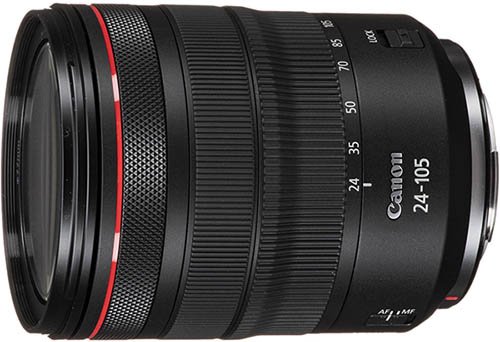
The Canon RF 24-105mm F4L IS USM is a full-frame lens with a very versatile focal range. On an APS-C camera like the Canon EOS R7 the full-frame equivalent focal length would be 38-168mm.
If you are looking for a lens that covers wide-angle, standard and telephoto focal lengths with a constant aperture of F4, then this might be the lens for you.
The autofocus is driven by Canon’s fast and ultra quiet Nano USM focus motor and there are 5-stops of Image Stabilization which increases to 8 stops when combined with the R7’s IBIS (In-Body Image Stabilization).
This zoom lens has a focal length of 24-105mm (38-168mm full-frame equivalent) and a fast maximum aperture of F4, the minimum aperture is F22. This lens does extend to zoom.
The minimum focusing distance is 45cm and the maximum magnification is 0.24x.
Canon USA’s Technical Advisor, Jon Lorentz takes a closer look at the Canon RF 24-105mm F4L IS USM lens in this video.
The lens is constructed from 18 elements in 14 groups and it has 9 aperture blades and a 77mm front filter thread.
The lens features a dedicated zoom, focus and control ring, an MF/AF toggle switch and IS (image stabilization) on/off switch. There’s also a zoom lock switch that locks the lens at 24mm to prevent the lens from extending when carrying it around.
The lens measures approx. 3.29 in. (83.5mm) in diameter and 4.22 in (107.3mm) in length. It weighs in at 24.7 oz. / 1.54 lb. / 700g.
Thankfully unlike the more budget friendly RF lenses the Canon RF 24-105mm F4L IS USM does include the Bayonet Lens Hood EW-83N and also a drawstring soft pouch LP1319.
To learn more about this lens we would recommending watching this review from Christopher Frost.
Pros:
- Very well built
- Extremely fast and quiet autofocus
- Excellent color rendition
- Great contrast
- Good sharpness across focal range
- Weather sealed
Cons:
- Prone to flaring
- Some barrel distortion at 24mm
- Small amounts of lateral CA
- Some vignette
9. Canon RF 70-200mm F4L IS USM
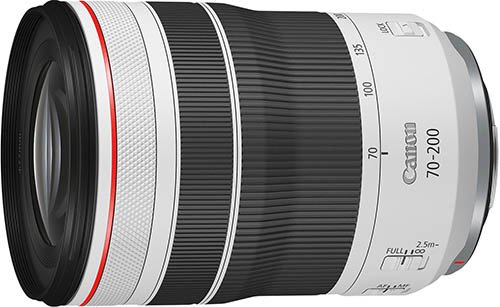
The Canon RF 70-200mm F4L IS USM is a full-frame zoom lens with a very compact and lightweight body. On an APS-C camera like the Canon EOS R7 the full-frame equivalent focal length would be 112-320mm.
If you are looking for a zoom lens then uses very little space in your backpack that is ideal for travel, sports and wildlife photography then this lens is worth taking a closer look at.
The autofocus is driven by Canon’s dual independent Nano USMs to help achieve high-speed focus and accuracy at any focal length. There are 5-stops of Image Stabilization which increases to 7.5 stops when combined with the R7’s IBIS (In-Body Image Stabilization).
This zoom lens has a focal length of 70-200mm (112-320mm full-frame equivalent) and a fast constant maximum aperture of F4, the minimum aperture is F32. This lens does extend to zoom.
The minimum focusing distance is 60cm and the maximum magnification is 0.28x.
Canon USA’s Mason Higa takes a closer look at the Canon RF 70-200mm F4L IS USM lens in this video.
The lens is constructed from 16 elements in 11 groups and it has 9 aperture blades and a 72mm front filter thread.
The lens features a dedicated zoom, focus and control ring, an MF/AF toggle switch, an IS (image stabilization) on/off switch along with 3 IS modes and a focus distance limiter switch with 2 settings (Full, 2.5m – Infinity). There’s also a zoom lock switch that locks the lens at 70mm to prevent the lens from extending when carrying it around.
Being an L lens there are also dust and water resistant seals so you can carry on shooting even if the weather takes a turn for the worse.
The lens measures approx. 3.1 in. (80.0mm) in diameter and 6.9 in (176mm) in length when extended and 4.68 in (119mm) when retracted. It weighs in at 27.51 oz. / 1.72 lb. / 780g.
The Lens Hood ET-78B is included in the box along with the Lens Case LP1224.
To learn more about this lens we would recommending watching this review from Christopher Frost.
Pros:
- Very small and light
- Extremely fast, quiet, and accurate autofocus
- 5 stops of image stabilization increasing to 7.5 stops with the R7’s IBIS
- Lovely bokeh and color rendition
- Very good contrast
- Excellent image quality across the frame
- Good control of aberrations and lens flare
Cons:
- Not compatible with 1.4x or 2x extenders
- Expensive
10. Canon RF 100-400mm F5.6-8 IS USM
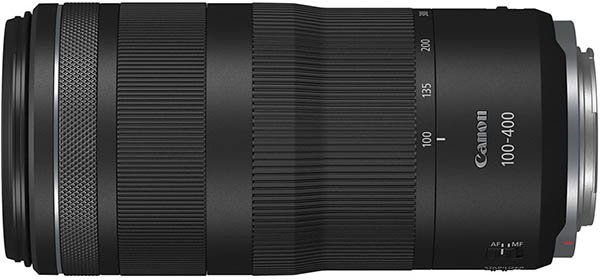
The Canon RF 100-400mm F5.6-8 IS USM is a full-frame telephoto lens that weighs just 22.4 oz. / 1.4 lb. / 635g. On an APS-C camera like the Canon EOS R7 the full-frame equivalent focal length would be 160-640mm.
If you are looking for a compact telephoto lens for shooting sports and wildlife with your R7 then this is definitely a zoom lens to consider.
The autofocus is driven by Canon’s Nano USM focus motor that delivers high-speed focus and accuracy throughout the focal length. There are 5.5-stops of Image Stabilization which increases to 6 stops when combined with the R7’s IBIS (In-Body Image Stabilization).
This zoom lens has a useful focal length of 100-400mm (160-640mm full-frame equivalent) and a variable maximum aperture of F5.6-8, the minimum aperture is F32 at 100mm and F45 at 400mm. This lens extends to zoom.
The minimum focusing distance is 88cm and the maximum magnification is 0.41x.
The lens also supports Canon’s RF 1.4x and 2x Extenders. The 1.4x increases the focal length to 140-560mm and aperture to F8-11. The 2x increases the focal length to 200-800mm and aperture to F11-16.
Canon USA’s Rudy Winston takes a closer look at the Canon RF 100-400mm F5.6-8 IS USM lens in this video.
The lens is constructed from 12 elements in 9 groups and it has 9 aperture blades and a 67mm front filter thread.
The lens features a dedicated zoom, focus and control ring, an MF/AF toggle switch, and an IS (image stabilization) on/off switch. There’s also a zoom lock switch that locks the lens at 100mm to prevent lens creep when walking around.
The lens measures approx. 3.13 in. (79.5mm) in diameter and 6.48 in. (164.7mm) in length when retracted, extending the zoom takes it to around 9.51 in. (241.7mm). It weighs in at 22.4 oz. / 1.4 lb. / 635g.
Sadly there is no lens hood included so you will need to purchase the Canon ET-74B separately (B&H). We would strongly recommend purchasing the lens hood for this lens as it will help to prevent lens flare and also protect the front element of the lens from accidental drops.
To learn more about this lens we recommending watching this excellent review from Christopher Frost.
Pros:
- Compact
- Low price
- Fast and quiet autofocus
- Good central sharpness over most of the zoom range
- Good control of aberrations
- Compatibility with 1.4x and 2x extenders
- Low vignette
Cons:
- Slow maximum aperture
- No weather sealing
- No lens hood included
- Poor corner sharpness
11. Canon RF 100-500mm F4.5-7.1L IS USM
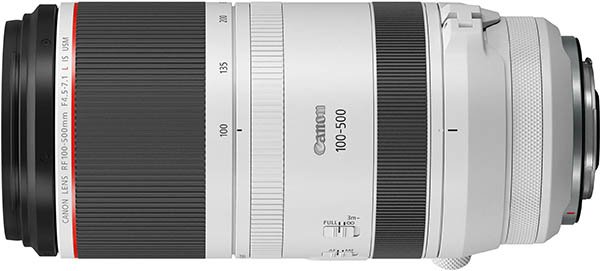
The Canon RF 100-500mm F4.5-7.1L IS USM is a full-frame telephoto lens with L-series build quality. On an APS-C camera like the Canon EOS R7 the full-frame equivalent focal length would be 160-800mm.
If you are looking for one of the best RF lenses for shooting sports and wildlife then you don’t really need to look any further than the RF 100-500.
The autofocus is driven by Canon’s Dual Nano USM motors that enable fast, smooth and near silent AF. 5-stops of Image Stabilization which increases to 6 stops when combined with the R7’s IBIS (In-Body Image Stabilization).
This zoom lens has a wide focal length of 100-500mm (160-800mm full-frame equivalent) and a variable maximum aperture of F4.5-7.1. The minimum aperture is F32 at 100mm and F40 at 500mm. This lens extends to zoom.
The minimum focusing distance is 90cm at 100mm and 120cm at 500mm. The maximum magnification is 0.33x.
Just like the RF 100-400, the RF 100-500 lens also supports Canon’s RF 1.4x and 2x Extenders. The 1.4x increases the focal length to 140-700mm and aperture to F6.3-13. The 2x increases the focal length to 200-1000mm and aperture to F9-18.
Canon USA’s Mason Higa takes a closer look at the Canon RF 100-500mm F4.5-7.1L IS USM lens in this video.
This video from wildlife photographer Robert Marc Lehmann and Canon Ambassador Richard Walch is also worth watching.
The lens is constructed from 20 elements in 14 groups and it has 9 aperture blades and a 77mm front filter thread.
The lens features a dedicated zoom, focus and control ring, an MF/AF toggle switch, an IS (image stabilization) on/off switch along with 3 IS modes and a focus distance limiter switch with 2 settings (Full, 3m – Infinity). There’s also a rotation-type torque ring adjustment that adjusts the zoom action from smooth to tight.
An adjustable lens collar allows you to easily rotate the lens when mounted on a tripod or gimbal via the included lens foot / tripod mount.
Being an L lens there are also dust and water resistant seals so you can carry on shooting even if the heavens open, although we would still recommend protecting your gear with a waterproof bag if you are shooting in wet weather for extended periods.
The lens measures approx. 3.69 in. (93.8mm) in diameter and 8.17 in. (207.6mm) in length when retracted, extending the zoom takes it to around 11.71 in. (297.6mm). It weighs in at 53.79 oz. / 3.36 lb. / 1525g with the tripod mount.
The Lens Hood ET-83F (WIII) is included in the box as is the Lens Case LZ1328.
I own this lens myself and it rarely leaves my R5. Here’s a shot of a beautiful male chaffinch in our garden.
To learn more about this lens we recommending watching this excellent review from Christopher Frost.
Pros:
- Useful focal length of 100-500
- Excellent image quality
- Reasonably light at 1525g with the tripod mount
- Lens hood is included
- Very fast and accurate autofocus
- 0.33x magnification
- Removable tripod collar
- Excellent aberration control
- Weather sealed
Cons:
- Very expensive
- Maximum aperture of F7.1 at 500mm
- Lens can not be fully retracted when used with extenders
12. Canon RF 800mm F11 IS STM
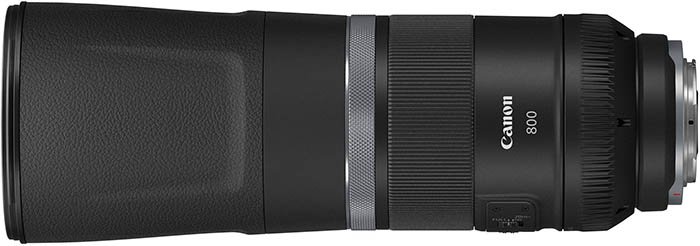
The Canon RF 800mm F11 IS STM is a full-frame telephoto prime lens with a very affordable price tag. On an APS-C camera like the Canon EOS R7 the full-frame equivalent focal length would be 1280mm.
Providing you have sunny skies this 800mm F11 lens is definitely worth considering if you plan to shoot wildlife or aviation with your R7.
The autofocus is driven by Canon’s STM focus motor and there are 4-stops of Image Stabilization which increases to 5 stops when combined with the R7’s IBIS (In-Body Image Stabilization).
This is a prime lens with a fixed focal length of 800mm (1280mm full-frame equivalent) and a fixed aperture of F11, there are no aperture blades to adjust the aperture. The lens needs to be extended before shooting.
The minimum focusing distance is 6m and the maximum magnification is 0.14x.
The lens also supports Canon’s RF 1.4x and 2x Extenders. The 1.4x increases the focal length to 1120mm and aperture to F16. The 2x increases the focal length to 1600mm and aperture to F22.
To learn more about the Canon RF 800mm F11 IS STM lens this video from Canon that also features the 600mm version is worth watching.
And also this video from video by Sabine Stols from Pangolin Photo Safaris.
The lens is constructed from 11 elements in 8 groups and it has no aperture blades to help keep the weight, size and cost down. There’s a 95mm front filter thread.
The lens features a focus and control ring, an MF/AF toggle switch, an IS (image stabilization) on/off switch and a focus distance limiter switch with 2 settings (Full, 20m – Infinity). There’s also a rotation-type lock to prevent the lens from extending.
The lens measures approx. 4 in. (101.6mm) in diameter and 13.85 in. (351.8mm) in length when shooting, when retracted the length is around 11.09 in. (281.8mm). It weighs in at 44.4 oz. / 2.77 lb. / 1260g.
There is no lens hood included so you’ll need to purchase the Canon Lens Hood ET-101 (B&H | Amazon) which we would strongly recommend for this lens to avoid flare and help to protect the front lens element.
If you are interested in this lens then we would again recommend watching Christopher Frosts excellent review.
Pros:
- Low price for an 800mm lens
- Compact size and lightweight
- Image stabilizer
- Excellent sharpness
- Good control of aberration, distortion and vignette
- Fast and accurate autofocus
Cons:
- Slow maximum aperture of F11 requires lots of light
- Lens needs to be extended before shooting
- Neither hood nor tripod foot included
- No weather sealing
- Poor autofocus in low light
- Minimum focusing distance of 6m
And that’s it for our 12 best lens recommendations for the Canon R7.
There are many more RF lenses available that you could mount to your R7, just keep scrolling down to view the complete list together with the latest firmware version for each lens.
Canon RF-S Zoom Lens List
There are currently only three Canon RF-S (APS-C) lenses available today for the R7 and both of these are zoom lenses.
| Lens | Filter Size (mm) | Latest Firmware | Check Price & Reviews |
|---|---|---|---|
| Canon RF-S 7.8mm f/4 STM Dual Lens | 58 | Release Firmware | Amazon | B&H |
| Canon RF-S 10-18mm F4.5-6.3 IS STM | 49 | Release Firmware | Amazon | B&H |
| Canon RF-S 18–45mm F4.5–6.3 | 49 | Release Firmware | Amazon | B&H |
| Canon RF-S 18–150mm F3.5–6.3 | 55 | Release Firmware | Amazon | B&H |
| Canon RF-S 55-210mm F5-7.1 IS STM | 55 | Release Firmware | Amazon | B&H |
Canon RF Prime Lens List
If you don’t mind purchasing the more expensive full-frame RF lenses then you’ll have a much larger choice for your R7. Here’s a complete list of all of Canon’s Prime RF lenses available today.
| Lens | Filter Size (mm) | Latest Firmware | Check Price & Reviews |
|---|---|---|---|
| Canon RF 5.2mm F2.8L Dual Fisheye | 35x20mm Rear-mounted | Release Firmware | Amazon | B&H |
| Canon RF 16mm F2.8 STM | 43 | Release Firmware | Amazon | B&H |
| Canon RF 24mm F1.4 L VCM | 67 | Release Firmware | Amazon | B&H |
| Canon RF 24mm F1.8 Macro IS STM | 52 | Release Firmware | Amazon | B&H |
| Canon RF 28mm F2.8 STM | 55 | Release Firmware | Amazon | B&H Photo |
| Canon RF 35mm F1.8 Macro IS STM | 52 | 2.0.2 | Amazon | B&H |
| Canon RF 35mm F1.4 L VCM | 67 | 1.0.6 | Amazon | B&H |
| Canon RF 50mm F1.4 L VCM | 67 | Release Firmware | Amazon | B&H |
| Canon RF 50mm F1.2L USM | 77 | 1.0.5 | Amazon | B&H |
| Canon RF 50mm F1.8 STM | 43 | Release Firmware | Amazon | B&H |
| Canon RF 85mm F2 Macro IS STM | 67 | Release Firmware | Amazon | B&H |
| Canon RF 85mm F1.2L USM | 82 | Release Firmware | Amazon | B&H |
| Canon RF 85mm F1.2L USM DS | 82 | Release Firmware | Amazon | B&H |
| Canon RF 100mm F2.8 L Macro IS USM | 67 | Release Firmware | Amazon | B&H |
| Canon RF 135mm F1.8 L IS USM | 82 | Release Firmware | Amazon | B&H |
| Canon RF 400mm F2.8 L IS USM | 52 mm (Drop-in) | 1.0.6 | Amazon | B&H |
| Canon RF 600mm F4 L IS USM | 52 mm (Drop-in) | 1.0.6 | Amazon | B&H |
| Canon RF 600mm F11 IS STM | 82 | Release Firmware | Amazon | B&H |
| Canon RF 800mm F11 IS STM | 95 | Release Firmware | Amazon | B&H |
| Canon RF 800mm F5.6 L IS USM | 52 mm (Drop-In) | 1.0.4 | Amazon | B&H |
| Canon RF 1200mm F8 L IS USM | 52 mm (Drop-In) | 1.0.4 | Amazon | B&H |
Canon RF Zoom Lens List
And here’s a complete list of all of the Canon RF full-frame zoom lenses available today for the R7.
| Lens | Filter Size (mm) | Latest Firmware | Check Price & Reviews |
|---|---|---|---|
| Canon RF 10-20mm F4 L IS STM | Rear filter for gels. | Release Firmware 1.0.5 | Amazon | B&H |
| Canon RF 14-35mm F4 L IS USM | 77 | 1.0.3 | Amazon | B&H |
| Canon RF 15-35mm F2.8L IS USM | 82 | 1.0.8 | Amazon | B&H |
| Canon RF 15-30mm F4.5-6.3 IS STM | 67 | Release Firmware | Amazon | B&H |
| Canon RF 16-28mm F2.8 IS STM | 67 | Release Firmware | Amazon | B&H |
| Canon RF 24-50mm F4.5-6.3 IS STM | 58 | Release Firmware | Amazon | B&H |
| Canon RF 24-70mm F2.8L IS USM | 82 | 1.0.8 | Amazon | B&H |
| Canon RF 24-105mm F2.8 L IS USM Z | 82 | 1.1.0 | Amazon | B&H |
| Canon RF 24-105mm F4L IS USM | 77 | 2.0.6 | Amazon | B&H |
| Canon RF 24-105mm F4-7.1 IS STM | 67 | 2.0.4 | Amazon | B&H |
| Canon RF 24-240mm F4-6.3 IS USM | 72 | 1.0.6 | Amazon | B&H |
| Canon RF 28-70mm F2.8 IS STM | 67 | Release Firmware | Amazon | B&H |
| Canon RF 28-70mm F2L USM | 95 | Release Firmware | Amazon | B&H |
| Canon RF 70-200mm F2.8L IS USM Z | 82 | Release Firmware | Amazon | B&H |
| Canon RF 70-200mm F2.8L IS USM | 77 | 1.1.4 | Amazon | B&H |
| Canon RF 70-200mm F4L IS USM | 77 | 1.1.1 | Amazon | B&H |
| Canon RF 75-300mm F4-5.6 | 58 | Release Firmware | B&H |
| Canon RF 100-400mm F5.6-8 IS USM | 67 | Release Firmware | Amazon | B&H |
| Canon RF 100-500mm F4.5-7.1L IS USM | 77 | 1.1.0 | Amazon | B&H |
| Canon RF 100-300mm F2.8 L IS USM | 112 | 1.0.8 | Amazon | B&H |
| Canon RF 200-800mm F6.3-9 IS USM | 95 | Release Firmware | Amazon | B&H |
Canon EF to RF Lens Mount Adapters
If you wish to adapt an older Canon EF or EF-S lenses to the R7 then one of the following adapters will be required.
| Mount Adapter Version | Check Price & Reviews |
|---|---|
| Canon Mount Adapter EF-EOS R | Amazon | B&H |
| Canon Control Ring Mount Adapter EF-EOS R | Amazon | B&H |
| Canon Drop-In Filter Mount Adapter EF-EOS R with Circular Polarizer Filter | Amazon | B&H |
| Canon Drop-In Filter Mount Adapter EF-EOS R with Variable ND Filter | Amazon | B&H |
Canon RF Extenders
Canon’s RF Extenders allow you to extend the focal length of certain lenses, although you will sacrifice one of two stops of light by adding them.
| Canon Extender | Lens Compatibility | Check Price & Reviews |
|---|---|---|
| Canon Extender RF 1.4x | Canon RF 100-400mm F5.6-8 IS USM Canon RF 100-500mm F4.5-7.1L IS USM Canon RF 100-300mm F2.8 L IS USM Canon RF 200-800mm F6.3-9 IS USM Canon RF 400mm F2.8 L IS USM Canon RF 600mm F4 L IS USM Canon RF 600mm F11 IS STM Canon RF 800mm F11 IS STM Canon RF 800mm F5.6 L IS USM Lens Canon RF 1200mm F8 L IS USM Lens | Amazon | B&H |
| Canon Extender RF 2x | Canon RF 100-400mm F5.6-8 IS USM Canon RF 100-500mm F4.5-7.1L IS USM Canon RF 100-300mm F2.8 L IS USM Canon RF 200-800mm F6.3-9 IS USM Canon RF 400mm F2.8 L IS USM Canon RF 600mm F4 L IS USM Canon RF 600mm F11 IS STM Canon RF 800mm F11 IS STM Canon RF 800mm F5.6 L IS USM Lens Canon RF 1200mm F8 L IS USM Lens | Amazon | B&H |
Canon Lens Acronyms
Canon along with other camera companies do like to make use of acronyms. Here are some of the most common ones you might see when looking at RF lenses.
USM
USM (Ultrasonic Motor) is an AF motor type used in Canon RF and EF lenses. This is the currently the fastest focusing motor in the Canon range.
STM
STM (Stepping Motor) is an AF motor used in Canon RF and EF lenses. You’ll typically find this motor in Canon’s more budget friendly lenses. It isn’t as fast or as quiet as USM lenses but still fast enough to capture stunning photos in most scenarios.
L
The L-series of lenses are Canon’s flagship lenses that deliver professional results by offering superior image quality and peak performance.
IS
IS (Image Stabilisation) helps to stabilize your images allowing you to shoot at slower shutter speeds and still maintain sharp images. The Canon EOS R7 also includes In-Body Image Stabilization (IBIS) which together with optical lens-based stabilization delivers up to 7 stops of protection from camera shake with the RF-S 18-150mm F3.5-6.3 IS STM lens and also offers the world’s highest level image stabilization at 8.0 stops when paired with certain lenses like the RF 24-105 F4.
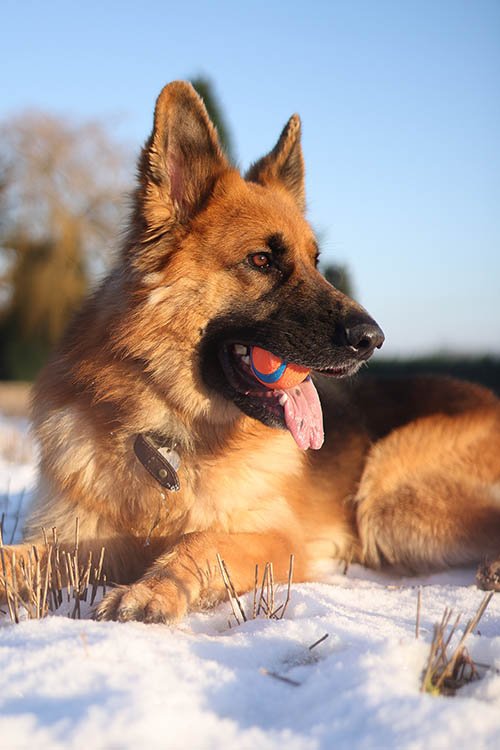


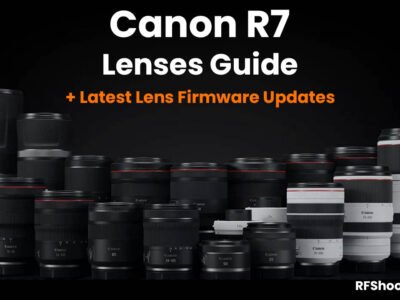

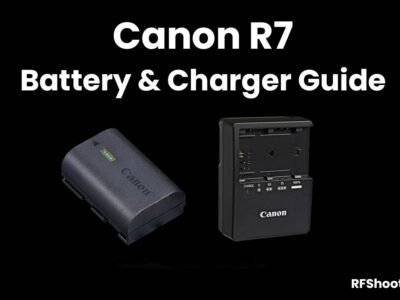
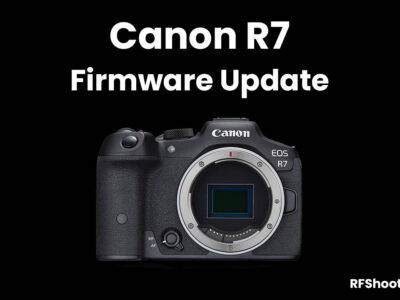

Glad you added the Sigma 10-18mm and 18-50mm RF-S f/2.8 zooms, but don’t overlook Sigma’s RF-S f/1.4 primes. There are four of them: 16mm, 23mm, 35mm, and 56mm. I have the 56, which is about the size of Canon’s nifty-fifty and brilliantly sharp.
I’ve pre-ordered Sigma’s 17-40mm RF-S f/1.8 zoom, which has all the reviewers on YouTube calling it “a bag of primes.” It’s physically larger than the others, about the same size as Canon’s RF 85mm f/2 Macro.
It would be nice to see a review of the Tamron 11-20 f2.8 for RF and compare it to the Sigma 10-18 f2.8
A suggested update:
Sigma and Tamron were licensed by Canon this spring to make fully-functional RF-S lenses, and over the summer Sigma introduced the first such lens, the 18-50mm f/2.8 DC DN RF fit lens.
This lens had been available for Sony, Fujifilm and Leica mirrorless cameras for a few years, and had a great reputation there, which gave Sigma a head-start. It’s sharp and small (about the same size and weight as the Canon RF-S 18-150mm kit lens), while is constant f/2.8 aperture lets in a lot more light.
It’s only downside is the lack of IS, but that impacts the other APS-C R bodies more it does the R7. since the R7 has IBIS.
One easy place to trip up in starting out with this lens is that the manual focus ring has been converted, on the Canon version, into a Control/Focus ring, like on some of Canon’s smaller RF primes – but with no switch or even labeling to indicate this dual role.
Its function is controlled through the camera’s setup menu, on the Focus tab, where you can set the function of combined Control/Focus rings to “Control” or “Focus.”
It took me a little while to figure this out, since I had set that menu Item to “Control” months before – and had months later decided to disable all Control rings as too easy to change by accident. The combined effect was to render this ring totally inactive.
Fortunately, changing the Focus menu setting for dual function rings from “Control” to “Focus” got it working properly as a manual focusing ring.
Highly recommended.
Hey Phil. Sorry, I’ve not checked the comments here for a few days. We certainly have nothing against third-party lenses, this article just needs an update which I hope to get around to in the next couple of weeks. I tend to shoot more with my Sony A1 than I do with my R5 right now, but my favourite lens for my A1 is the Sigma 500mm F5.6. I’d love to see Sigma bring this lens to the RF mount as well. So nope, we definitely don’t have anything against third party lenses, the more the merrier!
hi… hope this text of mine always sees you hale/healthy/happy – picture perfect clicks.
I am about to get hold of Canon EOS R7 with the kit lens 18-150mm STM. Request you to kindly suggest THE BEST LENS for
1. INDOOR PHOTOGRAPHY / AUDITORIUM PHOTOGRAPHY +
a. HOOD
b. BATTERY (ADDITIONAL)
c. MEMORY CARD
d. WRIST STRAP
e. FILTER
and your valuable guidance for cage / flash / microphone etc…
regards and good day
You include the EF to RF adaptors, but don’t list a single ef/efs lens. So this whole piece is really just a plug for RF lenses, and not valid journalism.
Our site is focused on the Canon R Series and RF lenses, hence the name RF Shooters. Which is why we have only included RF lenses in this list. I’m sure a quick Google search will return a similar list with EF / EF-S lenses.